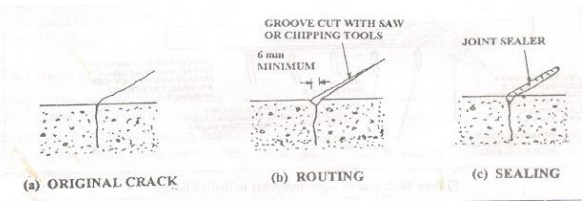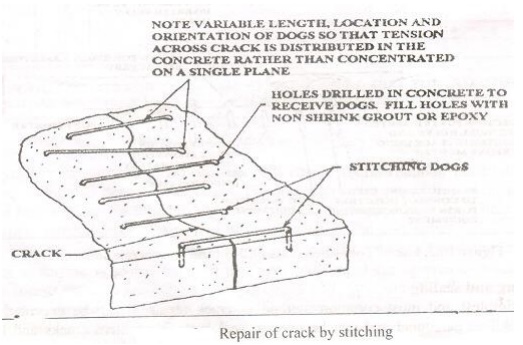Chapter: Civil : Repair and Rehabilitation of Structures : Repairs, Rehabilitation and Retrofitting of Structures
Cracking

Cracking
1Routing and sealing
This is the simplest and most common method of
crack repair. It can be executed with relatively unskilled personnel and can be
used to seal both fine pattern cracks and larger isolated cracks.
The system can be used to repair dormant cracks
that are of no structural significance, and is used to seal the cracks against
the ingress of moisture, chemicals and carbon dioxide. This involves enlarging
the crack along its exposed face and sealing it with crack fillers as shown
fig. Care should be taken to ensure that the entire crack is routed and sealed.

2 Stitching
In this technique, the crack is bridged with
U-shaped metal units stitching dogs before being repaired with a rigid resin
material. This can establish restoration of the strength and integrity of
cracked section; due care is to be given to make analysis check to ensure that
this will perform well under applied loads shown fig.

A non-shrink or an epoxy resin
based adhesive should be used to anchor the legs of the dogs. Stitching is
suitable when tensile strength must be reestablished across major cracks,
although stitching will not close the crack, and it is way of stopping the
movement of active crack and thereby preventing it from spreading. Stitching dogs
should be of variable length and orientation and so located that the tension
transmitted across the crack is not applied to a single plane within the
section but us spread over an area.
3Bonding
Cracks in concrete may be bonded
by the injection of epoxy bonding compounds under pressure. A usual practice is
to drill into cracks from face of the concrete at several locations. Water or a
solvent is injected to flush out the defect. The surface is than allowed to
dry. The epoxy is injected into the drilled holes until it flows out through
the other holes.
The epoxy is injected into the
drilled holes until it flows out through the other holes. Bonding with
epoxies-cracks as narrow as 0.0.75mm can be sealed with epoxy compounds,
usually pressure injection is restored to in sealing the cracks.
4 Bandaging
A flexible strip is fixed over
the crack with only the edged of the strip bonded. Where movement is not all in
one plane, where is excessive movement beyond that which can be accommodated by
a recess of convenient size, or if there are factors which prohibit the cutting
of a recess, a surface bandage can be used. In areas which are subject to
traffic, the flexible bondage will be coated over with a wearing course
Related Topics